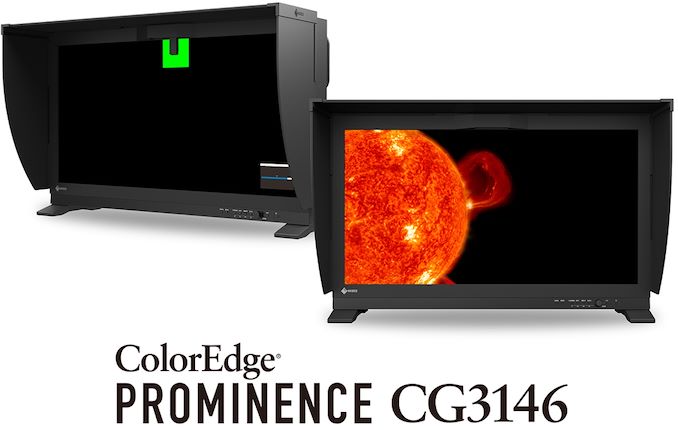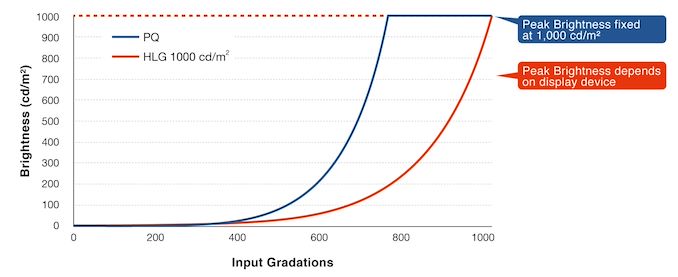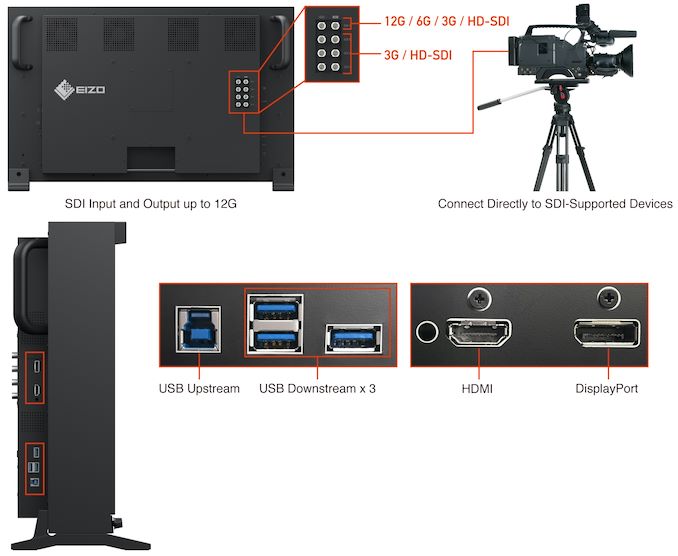EIZO Unveils ColorEdge Prominence CG3146 HDR Reference Monitor with Calibration Sensor
by Anton Shilov on March 2, 2020 2:00 PM EST
Well known for their high-end and reference-quality monitors, EIZO has introduced their latest reference monitor, the ColorEdge Prominence CG3146, which is designed for HDR content mastering for the broadcast and film industries. The new 31.1-inch monitor largely builds upon technologies developed for its predecessor, the CG3145, but has a number of enhancements, including a built-in calibration sensor and SDI connectivity.
The EIZO ColorEdge Prominence CG3146 monitor is based on a 10-bit IPS panel with a 4096×2160 resolution. All told, the monitor can reproduce 1.07 billion colors, and is assisted by EIZO’s proprietary wide-gamut LED backlighting. According to EIZO, the high-end backlighting tech can control backlight intensity on a per-pixel basis, which enables the LCD to display intensively bright colors and deep blacks without the kind of artifacts seen on monitors with coarser backlighting systems. By the numbers, the CG3146 offers a typical brightness of "just" 1000 nits, but also hits a rather whopping 1,000,000:1 contrast ratio.
The ColorEdge Prominence CG3146 covers 99% of the DCI-P3 color gamut and also supports sRGB, BT.2020, and BT.2100 color spaces. The monitor features a 24-bit 3D LUT (look-up table) for smooth color gradations and supports HLG (hybrid log-gamma) and the PQ (perceptual quantization) curve so that it can be used with various HDR modes/transports. For example, HLG’s luminance tops at 1000 nits (which is suitable for TVs), whereas PQ supports considerably higher brightness of up to 10,000 nits, which is required for recorded content.
Color accuracy is absolutely crucial for post production and color grading workloads, so the ColorEdge Prominence CG3146 comes with an integrated sensor that calibrates the monitor when needed and eliminates the need for an external calibrator device. Meanwhile, apart from qualities of the panel and backlighting, it depends on such factors as ambient and internal temperature of the monitor. To that end, the ColorEdge Prominence CG3146 is equipped with a temperature sensor that measures temperature inside the monitor and estimates temperature outside of it to adjust LCD’s settings in real time to ensure accurate colors. Moreover, the EIZO’s digital uniformity equalizer (DUE) technology not only ensures the right luminance, color temperature, and tones for stable image display across the screen, but also counterbalances the effects that a changing temperature may have on uniformity. Last but not least, the display has a light shielding hood.
Moving on to connectivity, EIZO’s new flagship HDR reference display offers an important improvement here. As expected, the ColorEdge Prominence CG3146 has a DisplayPort capable of DCI-4K with 4:4:4 chroma subsampling at 50/60 Hz, as well as an HDMI 2.0 input capable of DCI-4K with 4:2:2 at 50/60 Hz. Furthermore, the monitor has 12G/6G/3G/HD-SDI BNC inputs and outputs to connect SDI supporting devices, which is a huge improvement for the film and broadcasting industries.
| Specifications of the EIZO ColorEdge Prominence Reference HDR Display | |
| CG3146 | |
| Panel | 31.1" IPS |
| Native Resolution | 4096 × 2160 |
| Maximum Refresh Rate | 60 Hz |
| Response Time | 10 ms |
| Brightness | 1000 cd/m² (typical) |
| Contrast | '1,000,000:1' |
| Viewing Angles | 178°/178° horizontal/vertical |
| HDR | 24-bit LUT, various transports |
| Dynamic Refresh Rate | none |
| Pixel Pitch | 0.170 mm² |
| Pixel Density | 149 ppi |
| Display Colors | 1.07 billion |
| Color Gamut Support | DCI-P3: 99% Adobe RGB: ?% Rec. 2020: ?% sRGB: ? |
| Aspect Ratio | 1.9:1 |
| Stand | to be announced |
| Inputs | 1 × DisplayPort 1.4 1 × HDMI 2.0a/2.0b (HDCP 2.2) BNC (12G/6G/3G/HD-SDI) BNC (3G/HD-SDI) 1 × USB-B for monitor control and the USB hub |
| Outputs | BNC (12G/6G/3G/HD-SDI, through-out (active) BNC (3G/HD-SDI, through-out (active) |
| USB Hub | 3-port USB 3.0 hub |
| Launch Date | April 2020 |
EIZO will demonstrate its ColorEdge Prominence CG3146 flagship HDR reference monitor at NAB trade show in Las Vegas, Nevada, in in late April. The company intends to start shipments in April too, but the exact availability timeframe will vary from country to country.
The monitor is covered by a five-year warranty. Though it should be noted that, like other reference monitors based on similar tech, the company is only guaranteeing the monitor's operation for 30,000 hours of usage. The guarantee on brightness and color accuracy, in turn, is even tighter: the monitor's warranty only covers 10,000 hours there, and only when used at a color temperature of 6500K at 800 nits brightness.
Related Reading:
- EIZO Announces ColorEdge Prominence CG3145: 4096x2160, 98% P3 and HDR10
- EIZO Reveals Limited Edition 21.6-Inch Foris Mova OLED Monitor
- ASUS ProArt PA32UCG: The Ultimate Mini LED 4K 120 Hz Monitor with HDR 1600
- ASUS at CES 2019: ProArt PA32UCX 4K Monitor with 1000-Zone FALD Unveiled
- Acer Joins Mini LED Monitor Club with Professional-Focused ConceptD CM7321K













21 Comments
View All Comments
DanNeely - Monday, March 2, 2020 - link
How are they doing per pixel backlighting control? A 4k microLED backlight, or the double stack LCD that's been talked about for years but AFAIK never been produced?DanNeely - Monday, March 2, 2020 - link
Hmmm a monochrome 4k OLED backlight would be an option too I suppose; and degradation there might explain the 10k hour warranty.blackadde2 - Monday, March 2, 2020 - link
Dual cell LCD's have been around for a bit - the previous Eizo model (CG3145) and Flanders XM311K, for instance.Dolda2000 - Monday, March 2, 2020 - link
Why is the calibration of the sensor itself more trustworthy than the calibration of the display?PeachNCream - Monday, March 2, 2020 - link
It probably isn't, but not everyone has the equipment to perform calibration and, to extend your question one step further out, what makes the sensor in independent calibration equipment more trustworthy than the sensor in the monitor?Dolda2000 - Monday, March 2, 2020 - link
I'm certainly not experienced with monitor calibration, but I'd assume that you send an independent sensor out to a well-equipped institution for recalibration every so often, but it seems that would be impractical if every monitor you have has its own sensor that needs to be sent out.blackadde2 - Monday, March 2, 2020 - link
Eizo monitors with embedded colorimeters can do something called Sensor Correlation. You use a validated, high end spectrophotometer (eg. a Klein Instruments scope) and correlate the results with the results of the embedded sensor to create an offset, which you use to correct the monitor as it ages.Guspaz - Tuesday, March 3, 2020 - link
In professional environments, you re-calibrate based on ambient lighting and temperature, so re-calibrating very often is a thing.BDmobb - Monday, March 2, 2020 - link
Oled are no longer being used as a post production monitor. For good reason really. Oled tech being developed in age of SDR caters to basically all that one would need with a Standard Dynamic Range. Now in 2020 accurate and to be called HDR needs to be utilizing at least 1000 nits to be used in post production. Panasonic has pulled LG woled panels and added cooling system and other Techniques to get more brightness from Woled tech. Still today Dual Layer LCD has been adopted as the most used for post production.crimsonson - Monday, March 2, 2020 - link
I’m not sure where you get this idea from but Sony x300 is still extremely popular for HDR and high/end SDR color grading.LG OLEDs is still popular for client TV to do Dolby Vision HDMI tunneling.
Both Sony’s x310 and Flander Scientific’s dual layer has not the market penetration the x300.
At least in the US post prod of NY and LA. And AFAIK in London also.